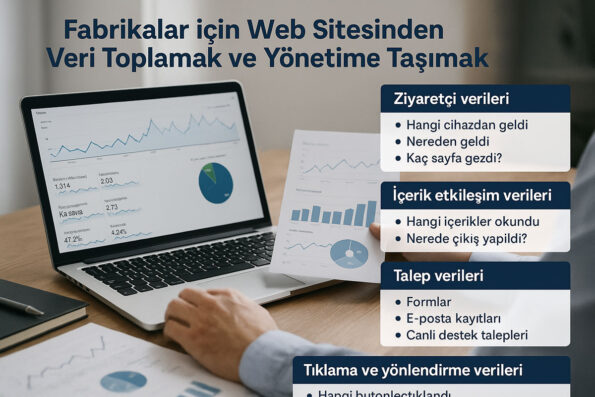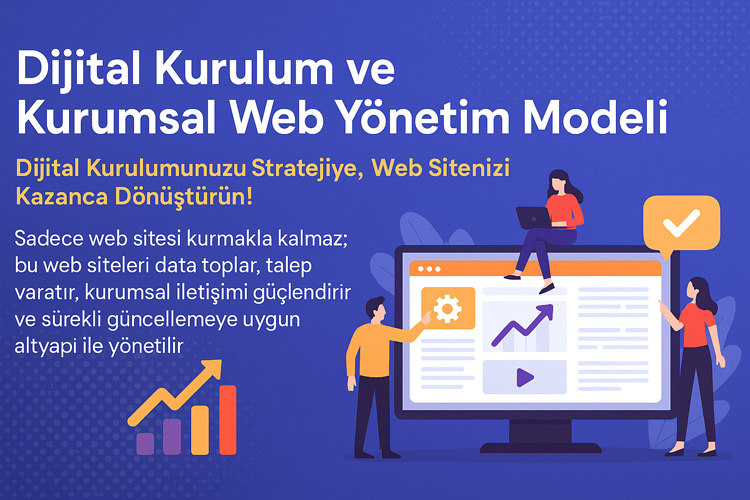Collecting Data from Websites for Factories: Data is produced in factories as much as production. However, a large portion of this data cannot be seen, is not recorded, and unfortunately, is often lost without being evaluated. However, one of the most important gains of digitalization today is the ability to manage via data. This is not limited to production data from machine sensors. Information coming through your website, demands in digital campaigns, content viewing levels, and more should now be considered a part of production.
So, is a website just a promotional area for a factory? Absolutely not.
A website for a modern factory is a strategic interface that both collects data and transfers this data to management processes. The Digital Installation and Corporate Web Management Model that we developed as Adapte Dijital takes websites from being just a showcase; it turns them into a system that produces, analyzes and feeds management processes with data.
In this article, we will explain in detail how you can collect data from your website, interpret this data and most importantly transfer this data to management, especially for factories and manufacturing companies. Our aim is; is to redefine the concept of a website and transform it into a system that works for you and produces information.

İçindekiler
Toggle1. Meaning and Scope of Data Collection from the Website
Collecting data from the website is not limited to just collecting the e-mail addresses of those who fill out the form.
A lot of information can be collected, such as the visitor’s behavior, the title they are interested in, which sector pages they spend more time on, which product they interact with, and even when they visit.
What are the Types of Data?
- Visitor data: Which device did they come from, where did they come from, how many pages did they visit?
- Content engagement data: Which content was read, where did they exit?
- Request data: Forms, email signups, live support requests.
- Click and referral data: Which buttons were clicked, which CTAs worked?
What is this data used for?
- It helps shape your marketing strategy.
- It helps you see which sectors you attract visitors from.
- You discover which demands drive R&D and production investments.
- Creates a pre-sale heat map.
Why is Data Collection an Investment?
Because data is the only way to plan not only the past but also the future.
A factory’s capacity is measured not only by its production power, but also by its demand forecast and accurate planning ability. The website is one of the most important sources of this insight.
Digital Installation and Corporate Web Management Model: Turn Your Digital Installation into Strategy and Your Website into Profit!
Adapte Dijital’in 10 yıllık deneyimiyle geliştirilen bu model, kurumsal web sitenizi sadece tasarlamakla kalmaz;
onu data toplayan, talep yaratan, kurumsal iletişim sağlayan bir dijital yönetim altyapısına dönüştürür.
Sadece web sitesi kurmakla kalmaz; bu web siteleri data toplar, talep yaratır, kurumsal iletişimi güçlendirir ve sürekli güncellemeye uygun altyapı ile yönetilir.

2. How to Set Up Data Collection Processes
Data collection is not a random action, but should be carried out within a corporate system.
At this point, Adapte Dijital’s model is built on 4 basic building blocks:
1. Content-Based Interaction Points
Every content is a data gate. Content is very important for collecting data.
A well-structured content attracts the target audience, keeps them on the page and starts collecting data with a form or redirection at the end of the content.
Example: At the end of the article titled “Our packaging machines special for the pharmaceutical sector”, the CTA “Leave your e-mail address to receive the PDF containing product details” is added.
2. Forms and Request Redirection Fields
A form field should be provided for each piece of information you provide to the visitor.
Form options covering different intents such as “I want to get a price”, “More information”, “Download product details”, “Request a reference” should be provided.
3. Visitor Analysis Tools and Software
Tools such as Google Analytics, Hotjar, Meta Pixel allow you to measure user behavior.
You can see where visitors spend more time, which buttons they click on, and which page they leave the site.
4. CRM Integration
The collected data must be transferred to the CRM system and should not be lost in the e-mail inbox.
The fact that every incoming data can be tracked offers ready opportunities for sales and marketing teams.
3. Transfer of Collected Data to Management
Collecting data is important, but what’s really valuable is processing that data and translating it into a decision.
Data > Information > Decision Chain
The collected data is filtered, clustered, graphed and presented to managers.
For example: “The textile sector has shown the most interest in the last month. The number of people who filled out the request form in this sector was 27. The most visited product was ‘multiple conveyor feeding system’.”
Creating Reporting Habits
In monthly meetings, not only production, sales and costs; digital data should also be on the agenda.
Your marketing team, together with your digital consultant, should turn this data into a “data-driven management” tool.
Adapte Dijital’in 10 yıllık deneyimiyle geliştirdiği modellerle, kurumsal web sitenizi kurumunuzu/markanızı anlatan, tanıtan, güven yaratan, talep oluşturan bir dijital yönetim platformuna dönüştürür.
Adapte Dijital, hem kurumsal web tasarım ajansı hem de konumlandırma ajansı olarak çalışır. Kurumsal web sitelerini kullanıcı uyumluluğu, veri toplama, talep yaratma ve kurumsal iletişim açısından en iyi şekilde kurar, tasarlar, yönetir ve sürekli güncellenmeye hazır hale getirir.
From Website Insights to Investment Planning
Product development plans can be made for the most demanded products.
Landing pages, ads, campaigns and videos can be produced for the sector from which the most data comes.
Data on the Management Floor Usage
Management is no longer just about intuitive decisions; should be able to act with weekly data reports.
With this data, managers can optimize campaign periods, promotion channels, and team task distributions.
Digital Installation and Corporate Web Management Model: Turn Your Digital Installation into Strategy, Your Website into Profit!

4. Why Should Factories Prioritize Website Data Collection?
Because understanding the interest in what you produce is as critical as producing it.
Demand Tracking
Which sectors are demanding from? Which products are of interest?
The answers to these questions guide not only the marketing department, but also the production planning team and the R&D unit.
Stock Planning
If the data from your website shows a rising interest in a product group; production and stock planning can be flexible accordingly.
Advertising and Budget Optimization
Where should the digital advertising budget be spent?
Data from the website clarifies the direction of the investment by revealing which keywords provide more conversion in which sector.
Brand Perception Management with Content Performance
Which content is read, which is not?
With this data, you can learn where your brand is “incompletely communicating” and strengthen yourself.

5. Transforming the Website into a “Data Engine” with the Digital Installation Model
The digital installation model offered by Adapte Dijital; makes the website not just a visible area but a data engine that works in the background.
Making the Site Architecture Suitable for Data Collection
Page structure, button placements, content flow, form structure and CTA points; is specially designed to collect data.
Landing Pages Specific to Each Sector
Special pages are opened for sectors such as machinery, textile, chemistry, medicine, defense, and user behavior from these sectors is analyzed separately.
Monthly Data Reports Presented to Managers
Every month, the data generated by the website is presented to the management in Excel, graphic and analysis formats. In this way, the data coming from the digital platform is reflected in the business processes.
Demand Scoring and Sales Conversion Process
Every incoming demand is analyzed; scored according to criteria such as temperature, relevance, urgency and directed to the sales department. With this system, potential opportunities from digital are converted into real sales.
Digital Installation and Corporate Web Management Model: Turn Your Digital Installation into Strategy, Your Website into Profit!
Conclusion
Your factory’s website is no longer a promotional area; it should be a system that produces data, processes data and transfers this data to management. Adapte Dijital’s Digital Installation Model builds this transformation in a practical, reportable and sustainable way. Our client Texpin used this model.
The more valuable the production, the more important is the market in which that production is received.
The way to understand and manage this return is to turn your website into a data center.
Take Action
Would you like to transform your factory website into a data-collecting platform that provides strategic insights to management?
Let’s make it happen with our step-by-step digital setup model.
Our first consultation is free – contact us now!






